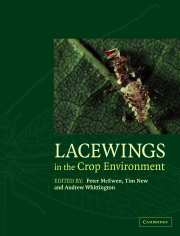Book contents
- Frontmatter
- Contents
- List of contributors
- Preface
- PART 1 Lacewing systematics and ecology
- PART 2 Lacewings in crops
- PART 3 Principles
- Introduction to Part 3
- CHAPTER 11 The use of lacewings in biological control
- CHAPTER 12 Mass-rearing, release techniques, and augmentation
- CHAPTER 13 Features of the nutrition of Chrysopidae larvae and larval artificial diets
- CHAPTER 14 Ecological studies of released lacewings in crops
- CHAPTER 15 Sampling and studying lacewings in crops
- CHAPTER 16 Interactions with plant management strategies
- CHAPTER 17 Lacewings, biological control, and conservation
- PART 4 Case studies
- PART 5 Conclusion
- Taxonomic index
- General index
CHAPTER 11 - The use of lacewings in biological control
Published online by Cambridge University Press: 04 May 2010
- Frontmatter
- Contents
- List of contributors
- Preface
- PART 1 Lacewing systematics and ecology
- PART 2 Lacewings in crops
- PART 3 Principles
- Introduction to Part 3
- CHAPTER 11 The use of lacewings in biological control
- CHAPTER 12 Mass-rearing, release techniques, and augmentation
- CHAPTER 13 Features of the nutrition of Chrysopidae larvae and larval artificial diets
- CHAPTER 14 Ecological studies of released lacewings in crops
- CHAPTER 15 Sampling and studying lacewings in crops
- CHAPTER 16 Interactions with plant management strategies
- CHAPTER 17 Lacewings, biological control, and conservation
- PART 4 Case studies
- PART 5 Conclusion
- Taxonomic index
- General index
Summary
HISTORICAL DEVELOPMENT
Lacewings have long been recognised as effective predators of aphids and other arthropod pests. More than 250 years ago, Réaumur (1742) discussed the use of lacewings for biological control of aphids in greenhouses (Stiling, 1985). Many early authors noted the large range and huge numbers of insect and mite pests consumed by lacewing larvae (Killington, 1936). Balduf (1939) stated that the Chrysopidae and Hemerobiidae were very effective biological control agents, feeding on some of the world's most important agricultural and horticultural pests. However, it was not until the 20th century that studies began on their potential for biological control. According to Ridgway & Murphy (1984) the first studies of the release of lacewings for control of a pest were those of Doutt & Hagen (1949, 1950), who examined the use of lacewings for the control of mealybugs. Later, Dunn (1954) investigated the potential of the hemerobiid Micromus variegatus Fabricius as a predator of aphids.
The principal factor limiting the manipulative use of lacewings for biological control has been that of producing large numbers economically. Finney (1948, 1950) began the first studies on the mass culture and distribution of Chrysoperla carnea. During the 1960s and early 1970s, work was carried out to devise an artificial diet for lacewings, to facilitate mass-rearing (Hagen & Tassan, 1965, 1966, 1970; Vanderzant, 1969; Butler & Ritchie, 1971). Improvements in rearing methods precipitated an increase in the number of trials of field releases of lacewings, particularly C. carnea, during the 1960s and 1970s.
- Type
- Chapter
- Information
- Lacewings in the Crop Environment , pp. 296 - 302Publisher: Cambridge University PressPrint publication year: 2001
- 35
- Cited by



